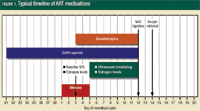Practical medical approaches to the patient with infertility
One in eight women of reproductive age has trouble getting pregnant. Knowing what drug treatments are available and how to use them can help you improve patient outcomes.
Ob/gyn practices often attract women from their late teens and early 20s to their 40s and beyond. Look in the typical waiting room and you're likely to see college students, young professionals, and married and single women of more advanced reproductive age. [Statistically speaking, one in every eight will be subfertile and at least 15% of women of reproductive age will go on to use some type of treatment for infertility.1] Clearly ob/gyns need to be aware of the latest treatment options for infertility and the current standard of care so that they can provide couples who are having trouble getting pregnant with accurate information, appropriate medical therapy-and if necessary, timely referral for more specialized care.

Oral ovulation induction
How to use SERMS. SERMS bind to estrogen receptors in the hypothalamus, reducing the negative feedback that estrogen produced by the growing follicle causes. That triggers release of gonadotropin-releasing hormone (GnRH), which results in secretion of pituitary LH and FSH.

[You can expect ovulation to occur in 50% of the patients you treat with 50 mg of clomiphene citrate daily for 5 days.2 For women who do not ovulate, you may need to increase the dosage in the next cycle to 100 mg daily for 5 days. The maximum dose of clomiphene typically used is 150 to 200 mg daily for 5 days.] If your patient does not become pregnant after four to six ovulatory cycles, consider doing further evaluation or using a different treatment. Statistically speaking, clomiphene will induce ovulation in 80% of women who are properly selected for the treatment.
The overall pregnancy rate is 70% to 75% after six to nine ovulatory cycles with clomiphene, but about 8% of the gestations will be multiple-mostly twins.2 Fetuses conceived during Clomid cycles generally do not have an increased rate of congenital malformations. Clomiphene's antiestrogenic effect on the uterus and cervix can result in decreased quality or quantity of cervical mucus, and it can also inhibit estrogen stimulation of the endometrial lining. In years past, there also was some concern that the drug might increase risk of ovarian cancer.3,4 But the epidemiologic studies on which the theory was based suffered from design flaws and newer epidemiologic research has not confirmed the association.5-7
Study links COVID-19 infection to higher low birthweight and preterm birth rates
March 24th 2025A new study found that pregnant women infected with COVID-19, especially in the third trimester or with severe symptoms, faced higher risks of preterm birth, low birthweight, and neonatal intensive care unit admission.
Read More
